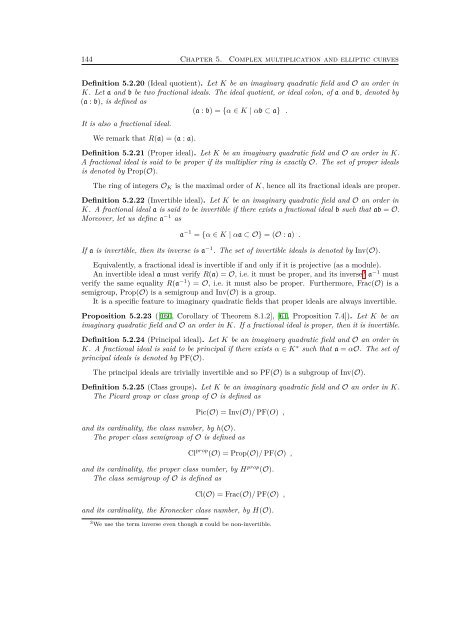here - Sites personnels de TELECOM ParisTech - Télécom ParisTech
here - Sites personnels de TELECOM ParisTech - Télécom ParisTech
here - Sites personnels de TELECOM ParisTech - Télécom ParisTech
Create successful ePaper yourself
Turn your PDF publications into a flip-book with our unique Google optimized e-Paper software.
144 Chapter 5. Complex multiplication and elliptic curvesDefinition 5.2.20 (I<strong>de</strong>al quotient). Let K be an imaginary quadratic field and O an or<strong>de</strong>r inK. Let a and b be two fractional i<strong>de</strong>als. The i<strong>de</strong>al quotient, or i<strong>de</strong>al colon, of a and b, <strong>de</strong>noted by(a : b), is <strong>de</strong>fined as(a : b) = {α ∈ K | αb ⊂ a} .It is also a fractional i<strong>de</strong>al.We remark that R(a) = (a : a).Definition 5.2.21 (Proper i<strong>de</strong>al). Let K be an imaginary quadratic field and O an or<strong>de</strong>r in K.A fractional i<strong>de</strong>al is said to be proper if its multiplier ring is exactly O. The set of proper i<strong>de</strong>alsis <strong>de</strong>noted by Prop(O).The ring of integers O K is the maximal or<strong>de</strong>r of K, hence all its fractional i<strong>de</strong>als are proper.Definition 5.2.22 (Invertible i<strong>de</strong>al). Let K be an imaginary quadratic field and O an or<strong>de</strong>r inK. A fractional i<strong>de</strong>al a is said to be invertible if t<strong>here</strong> exists a fractional i<strong>de</strong>al b such that ab = O.Moreover, let us <strong>de</strong>fine a −1 asa −1 = {α ∈ K | αa ⊂ O} = (O : a) .If a is invertible, then its inverse is a −1 . The set of invertible i<strong>de</strong>als is <strong>de</strong>noted by Inv(O).Equivalently, a fractional i<strong>de</strong>al is invertible if and only if it is projective (as a module).An invertible i<strong>de</strong>al a must verify R(a) = O, i.e. it must be proper, and its inverse 3 a −1 mustverify the same equality R(a −1 ) = O, i.e. it must also be proper. Furthermore, Frac(O) is asemigroup, Prop(O) is a semigroup and Inv(O) is a group.It is a specific feature to imaginary quadratic fields that proper i<strong>de</strong>als are always invertible.Proposition 5.2.23 ([160, Corollary of Theorem 8.1.2], [61, Proposition 7.4]). Let K be animaginary quadratic field and O an or<strong>de</strong>r in K. If a fractional i<strong>de</strong>al is proper, then it is invertible.Definition 5.2.24 (Principal i<strong>de</strong>al). Let K be an imaginary quadratic field and O an or<strong>de</strong>r inK. A fractional i<strong>de</strong>al is said to be principal if t<strong>here</strong> exists α ∈ K ∗ such that a = αO. The set ofprincipal i<strong>de</strong>als is <strong>de</strong>noted by PF(O).The principal i<strong>de</strong>als are trivially invertible and so PF(O) is a subgroup of Inv(O).Definition 5.2.25 (Class groups). Let K be an imaginary quadratic field and O an or<strong>de</strong>r in K.The Picard group or class group of O is <strong>de</strong>fined asPic(O) = Inv(O)/ PF(O) ,and its cardinality, the class number, by h(O).The proper class semigroup of O is <strong>de</strong>fined asCl prop (O) = Prop(O)/ PF(O) ,and its cardinality, the proper class number, by H prop (O).The class semigroup of O is <strong>de</strong>fined asCl(O) = Frac(O)/ PF(O) ,and its cardinality, the Kronecker class number, by H(O).3 We use the term inverse even though a could be non-invertible.
















